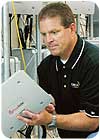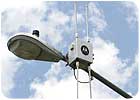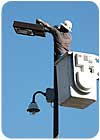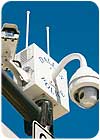

Wireless mesh nodes from Firetide Inc., Los Gatos, Calif., are configured and placed into enclosures as part of a deployment for the Dallas Police Department.
With point-to-point video transmission, data is sent from a single antenna to another. In point-to-multipoint, a single antenna broadcasts to several.
“The biggest advantage of the mesh is cost-effective deployment within the infrastructure,” maintains Mike Fabbri, director of data solutions operations for Motorola Inc., Schaumburg, Ill. “I don’t have to have fiber at every access point. I can hop from an access point to where fiber is connected.”
Bert Williams, vice president of marketing for Tropos Networks Inc., Sunnyvale, Calif., points out another advantage.
“The mesh forms a cloud of coverage over the area, so you can safely add, remove or change the location of cameras without having to worry about readjusting the network every time you do that,” he declares.
Wireless mesh networks can be set up quickly because they require minimal cabling for connections and can justify their cost by being used to carry other data.
Some of this other data can include access control and alarm system information, voice over Internet Protocol (VoIP) telephone calls, parking or utility meter readings, medical information to ambulances, intelligent control of traffic devices like stoplights and electric signs, and the Internet itself.
Information can be exchanged over the mesh to evaluate video, such as accessing public databases for additional information or photos on individuals of interest, or to notify people or file reports, Williams notes.
Mesh networks can be set up instantaneously when a number of mobile mesh video servers such as those in laptops converge on an area.
Tom Hansen, CEO of AirVisual Inc., New York, emphasizes that mesh networks are not created equal in their ability to move information through different routes.
“The other thing to consider about the mesh networks is that we really look for the ability to self heal itself or self-configure,” Hansen stresses. “These are all features that the buyer or the integrator deploying the system really has to be aware of. They’re not all the same — it’s a matter of doing your homework and having some knowledge of the network you deploy.”

The locations of IAP7300 wireless gateways from Motorola Inc., Schaumburg, Ill., are not critical due to the self-forming nature of the mesh network. The intelligent access point acts as the transition from the wireless network to the wired world.
ADDING CAPACITY
If video would consume too much bandwidth on a wired network, a mesh network can be dedicated for video. “The installation of an independent network for the video has the advantage of adding incremental capacity, and in doing so, you’re able to get the headroom you need to run the video,” Williams suggests.Hansen sees installing wireless networks in parallel with wired or other wireless networks growing in popularity. “Having a mesh network as an add-on to already existing networks is bringing more redundancy and greater communication out to the end users,” he points out.
The relative cost advantage of using mesh networks for video depends on the availability of a wired alternative. “If you already have a rich wired infrastructure, particularly if you have spare cable bundles so you don’t have to pull new cable to do it, expanding the wired infrastructure would be the way to go,” Williams recommends.
“If you’re in an area that is hard to wire, that’s where wireless mesh networks really shine,” he asserts. “If you’re in an area where for some reason the topography logistically is hard to wire, then they can be substantially less expensive than a wired network.”
Point-to-point or point-to-multipoint video transmission can be used in conjunction with mesh networks.
“The value of the mesh is the way it allows me to be able to communicate reliably in a broadband fashion to and from moving vehicles, so I might use both technologies in a given customer deployment,” Fabbri declares.
Manish Chandra, director of product management for Firetide Inc., Los Gatos, Calif., emphasizes the advantages of scalability that are obtained with a mesh network.

The power for mesh network equipment from Tropos Networks Inc., Sunnyvale, Calif., and a video dome is being attached to the photocell receptacle on the street light.
“Keeping that scalability road map in mind today is very important, so that you can grow your network using the technology,” he asserts. “You would rather spend the investment in terms of time upfront so you can get the results that you expect from that network, scaling it in the future, and that is a very key point for wireless video surveillance networks.”
But older networks have technology limitations. “The real obstacle that we’re seeing out there is how customers are becoming more and more demanding as to how they want mesh networks deployed,” Hansen says. “It all matters on what you’re trying to do. If you bought a system five to 10 years ago for just simple text messaging (SMS), an SMS string is nothing but some piece of code.”
Streaming video over that same old network to 100 squad cars is another matter. “I would say it’s impossible,” Hansen insists. “You’ve got mesh networks that vary in quality, but it’s really about how creative you can be as you deploy these systems.”
Some of that creativity is required to create interoperability for wireless systems. “You can have so many different flavors of wireless and mesh networks,” Hansen laments. “How do you tie all that together to deliver interoperability? We’re seeing more and more of this drive for the open architecture environment to make all this work.”

The expansion and modification capabilities of mesh networks make the 2200 system from Fluidmesh Networks Inc., Boston, suitable for this airport.
HIPPITY-HOPPING ON THE MESH
The critical part of a wireless mesh network is the capacity of its backhaul, the wired network that carries back the data, maintains Nelson Santos, vice president of business development for integrator Scientel Wireless LLC, Lombard, Ill.“How do you bring that video back to the video server?” Santos asks. “That is most critical. That’s where the quality of the video coming back is going to give you the results.”
In municipal installations of wireless mesh video, Santos recommends determining where the municipality may already have fiber-optic or networking cable installed in what are called “gateway nodes” and designing the wireless mesh video network around that. “At the end of the day, the gateways will determine how much capacity your mesh network truly has,” he points out. “We have two basic pieces of infrastructure — they all call them different things.
“The gateway is really the congestion rod,” Santos maintains. “Every time you add a repeater, there’s a hop, hop back to the gateway, making sure that first, you’re not putting in too many hops.
“So typically, we try to design it so you have no more than three or four hops before one of those repeater mesh nodes can get back to one of those gateway nodes,” Santos explains. “It’s important not to stretch out the mesh network’s limits because video provides more of a demand for the network. It’s not completely wireless because you still need to tie it into the physical network.”
Although each camera sends and receives signals in the network, latency can increase and bandwidth can strain if more than three or four cameras are between gateways, Santos maintains.
In level terrain, each camera may be up to a mile apart, but in more urban or hilly locations, that distance may be reduced to a half-mile. So three or four “hops” of cameras may be from two to four miles depending on the terrain.
Another consideration in designing such networks is the amount of additional traffic from other sources, Santos notes. So in a municipality, wireless mesh communications may be originating from other departments, such as fire, meter reading, water monitoring for public works, etc. The amount of this traffic determines how much bandwidth is left for video.
Finally, a seemingly simple concern can require a surprising amount of time to research — who owns the poles to which cameras and mesh video equipment may be attached.
“That is probably the No. 1 biggest hurdle,” Santos admits. Agreements must be struck with all owners of poles and usually monthly rentals paid if they are not owned by the entity installing the mesh network and cameras. That can increase the overall cost of a mesh network.

The outdoor pod has a wireless mesh node inside from Firetide Inc., Los Gatos, Calif.
ENCRYPTION IS KEY
Because mesh signals are transmitted through the air, they are more accessible to being intercepted by unauthorized users. Robust encryption or a unique protocol can prevent that. Many systems use 256-bit AES encryption, but it always must be enabled in case users forget to turn it on, reminds David Engebretson, SDM’s contributing technology writer.Another consideration he points to is where the information is decrypted — at the tower where it is received and then sent on a wired or another wireless network to the user, or at the user’s computer? The more secure method is to decrypt at the user’s computer, but a more powerful and more expensive computer must be used.
Chandra points out that once the mesh video has been decrypted and distributed over wires or wirelessly within a facility, those systems can have their own encryptions to provide security.
“You do have to make sure the security is end-to-end and the user traffic is not compromised,” Chandra advises. Such security usually is the province of the person managing the network and sometimes is determined by agreements with the network provider.
Although many wireless mesh networks use various versions of Wi-Fi’s 802.11 protocol languages to communicate, the wireless system offered by Fluidmesh Networks Inc., Boston, uses a proprietary language.
“Fluidmesh implemented its own communication protocol designed from scratch,” maintains Umberto Malesci, Fluidmesh’s president and co-founder. “The language that Wi-Fi devices use has not been designed around the needs of the security market in terms of performance, latency and reliability.”
Malesci maintains that because his company’s protocol is proprietary, encrypting is not required except in high-security applications. “Nobody knows how the protocol works, which makes it harder to hack into the system,” he asserts.
Engebretson points out that latency — a time delay in receipt of video — can be affected by the degree and speed of encryption, because it adds additional information to the packets of video data transmitted. That additional size can result in increased time to transmit. This means a time lag may be experienced by those responding to live video, such as through a pan-tilt-zoom (PTZ) camera.
Malesci thinks that latency is more a function of the processing power of the monitor’s computer than a problem. His company’s protocol gives priority to IT data packets with PTZ information.
“We look at the initial bits of the packet, and we recognize a different pattern, and by the pattern, we know if it is a PTZ control packet or a video packet,” he explains. “You are able to move a joystick control and the camera reacts immediately, like on a wired network.”
His system also gives priority to “I” frames of video that have the full image in them rather than the “P” frames that only contain the changes in the full video image. “I” frames are sent every 1 or 2 seconds. If a “P” frame or two are missed, it can slow 15 frame-per-second (fps) video to 14 or 13 fps, which Malesci maintains is not noticeable.
Another difference with Fluidmesh’s system is that its proprietary protocol and/or encrypting is maintained all the way to the receiving computer in a control room.
“We suggest going to the control room encrypted — it is called end-to-end encryption,” Malesci advises. “Sometimes it is easier to access data in the wired rather than wireless portion, so it’s very important wherever you are on the network that the entire path of your stream is encrypted.”
With many Wi-Fi systems, the video is only encrypted while it is being transmitted wirelessly. Once it connects with a wired system, the video is decrypted. If it is transmitted through a network’s standard Wi-Fi system in a building, it uses standard Wi-Fi encryption. Malesci recommends 256-bit AES encryption, which most Wi-Fi systems use.
Some mesh networks can mix wired and wireless video. “The beauty of mesh is that you are able to integrate different wireless systems with wire, so within a whole network, you could have wired or wireless links, but to the end user, it is just one Ethernet network end-to-end,” maintains Chandra. “You get an Ethernet kind of infrastructure over a wireless media.”